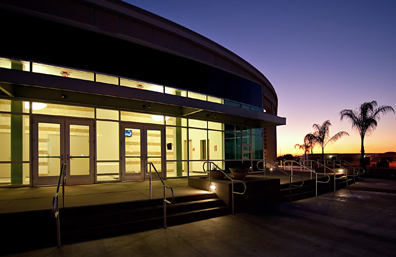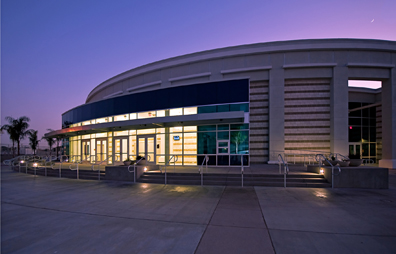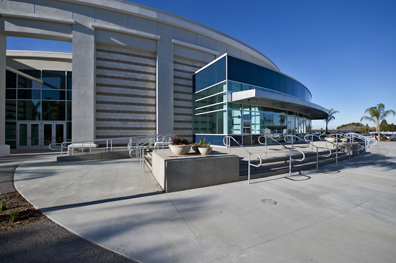Chula Vista High School’s Green Renovation

Students at a Southern California high school start 2011 off with new green-standard facilities, the result of a $644 million school construction bond program. Renovations at Chula Vista High School near San Diego are on target to receive Gold LEED ratings and include a new multi-use creative arts building, a new library, a gymnasium remodel, and locker room upgrades.
Funding for the projects comes from Proposition O, which passed in 2006 and targets the 32 high schools and middle schools in the Sweetwater Union High School District.
“Each of the Prop. O projects, if they are new construction, they have to be at least LEED-Gold,” says Jaime Ortiz, the Prop. O bond manager working with SGI Construction Management. “That was a directive from the board of trustees and the superintendent. It’s a pretty bold statement that the district wanted to make as far as sustainability. And we’ve designed these buildings to be highly efficient in every way. These buildings are highly efficient when it comes to using energy, water, daylight, and irrigation.”
SUHSD is the largest secondary school district in the nation, serving 43,000 middle and high school students and 27,000 adult learners. It is the southernmost district, covering from the Mexico border north to the edge of the city of San Diego, and from the Pacific Ocean east to Chula Vista. SUHSD includes four cities: National City, Chula Vista, Imperial Beach and parts of southern San Diego.
Located in a particularly underserved and economically impoverished neighborhood, CVHS counts a culturally diverse student body comprised of 80 percent Hispanic and 10 percent each of white, Asian and African-American students.
“It’s in a socio-economically challenged part of town, so it is really great to give these children state-of-the-art learning facilities because it sends a message that they are just as important as anybody else,” Ortiz says. “The schools in the rich part of town shouldn’t have any better facilities than the ones in the poorer parts of town.”
The centerpiece of the school’s $20.9 million in improvements is a 25,729-square-foot, multi-purpose creative arts building that features a 680-seat theater, band room, choir room, dance studio and mariachi/orchestra room. An estimated one-third of the CVHS’s 2,900 students enroll in its School for Creative and Performing Arts, further fueling the need for a noteworthy facility.

Other improvements include a new 5,600 square foot, Grecian-style library equipped with computer stations and a study area/work room. Gymnasium upgrades include a new floor, as well as new bleachers, backboards, lights and scoreboard. Additionally, locker rooms were modernized with new flooring, new lockers and a new air conditioning system.
BCA Architects designed the project and Turner Construction was the general contractor. Both were selected through a qualification-based selection process.
“We were looking for companies that could deliver high-quality projects on schedule and on budget, while at the same time helping us achieve our LEED objectives,” Ortiz said. “Turner Construction is one of the largest contractors in the country. They completed many LEED projects before and have a wealth of resources that they could tap into if needed. They really hit the ground running and made this project move really quickly.”
“The architects, BCA, really listened to what the school wanted and then designed this gorgeous building,” Ortiz said. “Their aesthetic sense is really well-defined.”
The design phase typically takes about a year to a year and a half to go through the division of state architects, and then construction took about 18 months, Ortiz explained. Once construction began on the large-scale project, building amidst a fully functioning, 2,900-student high school campus presented its own logistical challenges.
“We were constantly working around the students,” he said. “Safety was at the forefront of everybody’s mind, obviously, and we also worked around testing schedules that the school had.”
Ortiz added that a constant challenge of school projects is to give students the most possible with the funding available, being as efficient as possible with the taxpayer’s money. In this case, designing the project with an ecologically sustainable focus resulted in access to about $300,000 in funding from the state — in the form of high-performance school grants — that would not have been available otherwise.
Going for Gold in Green
Ortiz said that he expects the CVHS projects to earn LEED Gold certification.
“We expect to see about 30 percent less energy usage than traditionally designed theaters and libraries, and we accomplish this through highly efficient light fixtures, solar panels, highly efficient air conditioning systems, a well-insulated building envelope, and light sensors in every room that automatically turn off the lights when the rooms are not in use,” he said. “We also have lots of natural daylight in the room, reducing the need for artificial illumination.”
Water usage is 40 percent less than that of traditionally built buildings of similar size and use, the result of using dual-flush toilets and waterless urinals, in addition to drought tolerant, native species in the landscaping. Low VOC paints, sealants and adhesives were used in construction and the carpet installed is made from recycled materials.
Additionally, 20 percent of all the materials used contained some sort of recycled content and 89 percent of the generated construction waste went to recycling plants rather than landfills.
Incorporating the green enhancements from the project’s inception kept costs in check, said Ortiz.
“I think that if you design the project correctly and efficiently from the start, your green project shouldn’t have any cost premiums over a traditionally built project,” Ortiz said.
“Manufacturers of sustainable construction materials are very competitive today. It’s not like it was four years ago when a green product was so much more expensive. Right now, the entire industry is moving towards sustainability so all the materials are very competitive right now. What you do have to do is make sure that you design it sustainable from the very beginning. The architect and entire design team has to think about things a little bit differently and has to be smart about how they are designing the project and make the project as efficient as possible.”

More Prop. O Funding Ahead
There is still plenty of construction funding slated to come from Prop. O. The scope of work includes upgrading classrooms, restrooms, science labs, libraries and technology, handicap accessibility, asbestos and lead paint removal, and upgrading fire and life safety systems. The first bond sale under the program was $180 million and SUHSD is slightly past the middle of the program’s first phase, which comprises nine large-scale construction projects on nine different campuses. Two of the nine projects have been completed and Ortiz estimates they are about 70 percent through the first phase.
The program originally was scheduled for four phases, Ortiz says. But that could change.
“It depends upon the assessed value of the district and how quickly the district can sell bonds into the financial market, and that depends upon the value of the properties in the district,” he explained. “So it’s kind of a complicated formula to determine when we can get the next pot of money.”
He said that he hopes the design process for Phase Two will begin within the next few months.
Although more projects are slated for Phase Two at CVHS, they are not identified yet. Some of the projects under consideration are potentially a new two-story classroom building and a new cafeteria, but that’s still to be defined by the school, the board, and the superintendent.
“We will go back to the school and review the priority list that they had established prior to us starting the design of the next phase,” Ortiz says.
